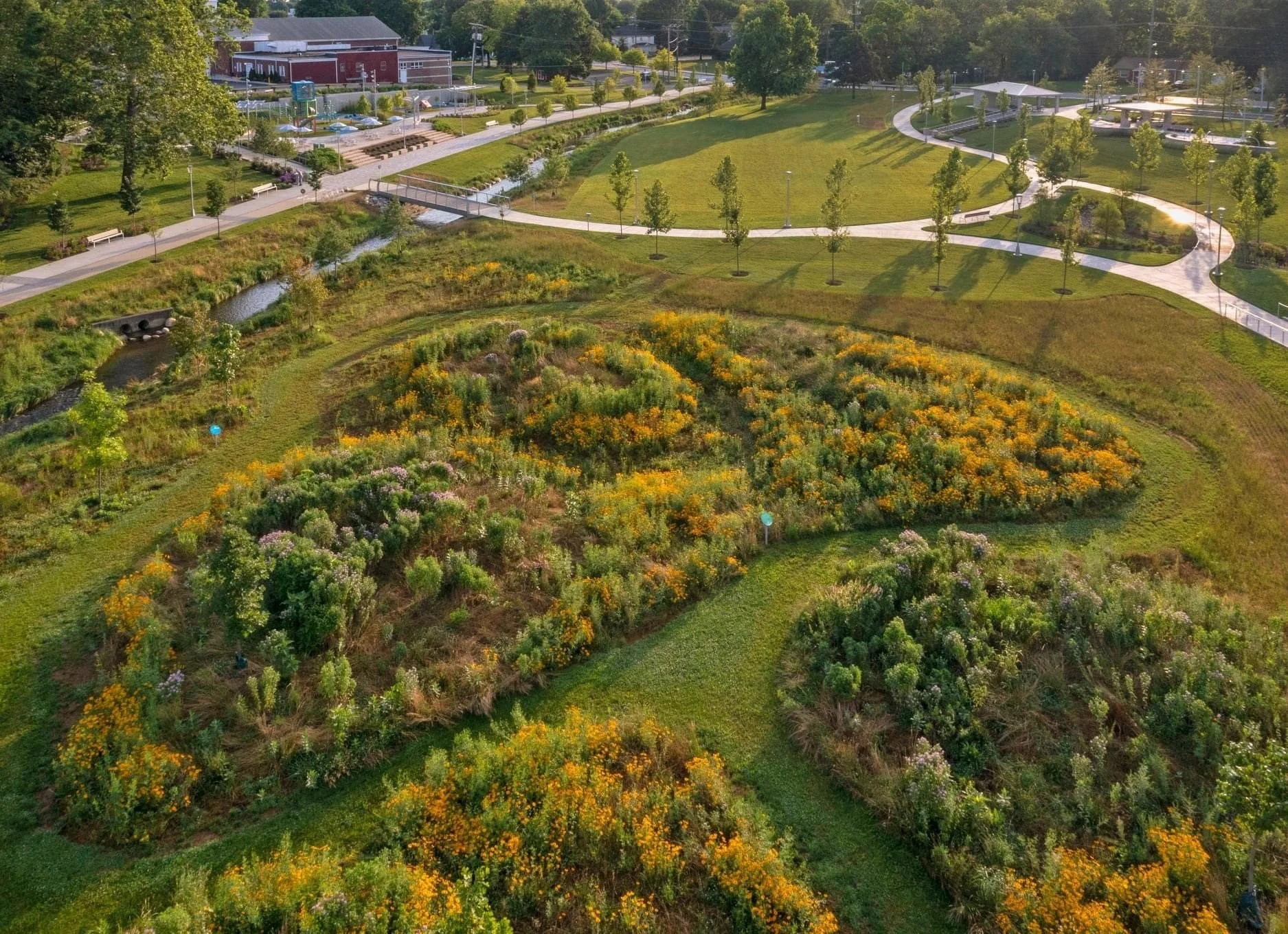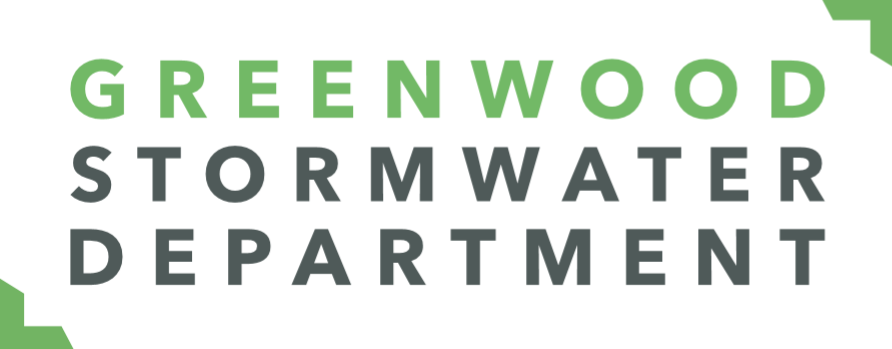Please fill out submissions box at the bottom of this page after reading.

What is Stormwater?
Stormwater is water from rain or melting snow. It flows from rooftops, over paved streets, sidewalks and parking lots, across bare soil, and through lawns and storm drains.
Stormwater that does not soak into the ground becomes surface runoff. As it flows, runoff collects and transports soil, pet waste, salt, pesticides, fertilizer, oil and grease, litter and other pollutants. This water drains directly into nearby creeks, streams and rivers, without receiving treatment at sewage plants.
Polluted stormwater contaminates local waterways. It can harm plants, fish and wildlife, while degrading the quality of water.
Everything that happens on land reflects in the water.
Pictured above is a image explaining how stormwater flows through the US, eventually running all the way down to the Gulf of Mexico.
Here we see the ‘dead zone’, or where the Mississippi River meets the Gulf of Mexico. You can clearly see the degradation of the water from the Mississippi, because of all of the pollutants the river collected on its way to the Gulf. This is devastating to aquatic life and can in turn effect humans.
The City of Greenwood is a Municipal Separate Storm Sewer System (MS4)
A separate storm sewer system is a collection of structures, including retention basins, ditches, roadside inlets and underground pipes, designed to gather stormwater from built-up areas and discharge it, without treatment, into local streams and rivers.
It's called a separate system because it's not connected to the sanitary sewer system which drains waste water from inside a home to a sewage treatment facility or a private septic system. Some communities do have combined storm and sanitary sewers.
Minimum Control Measures (MCMs)
For our MS4 permit, permittees (the Stormwater Department) are required to develop and implement a Storm Water Management Program (SWMP) that must include:
pollution prevention measures
treatment or removal techniques
monitoring
use of legal authority
and other appropriate measures to control the quality of stormwater discharged.
Here is how we meet this criteria:
-

MCM 1: Public Education and Outreach
A well-educated community can benefit a MS4 in many ways. Individuals can take action on their property, as well as around the city, to prevent polluted stormwater runoff.
We rely on all members of an MS4 community knowing what stormwater is, ways to manage it, and the sources of water pollution.
In order to reach our audience, we utilize our Nature Center, social media, promotional items, as well as other avenues to encourage our citizens to contribute to environmental health. We advocate for green solutions that compliment Greenwood’s native habitat.
Pictured Above* A demonstration of oil pollution and the difficulties of removal.
-

MCM 2: Public Involvement
We provide our citizens with the opportunity to be actively involved in improving the water quality. We do this by offering events at the Nature Center that focus on environmental health. Types of topics we cover are: native plants, water conservation (rain barrels, water testing), native birds, aquatic animals, etc. We will also routinely host creek clean ups. Keep an eye out on the City of Greenwood Facebook page for dates.
Pictured Above* Locals cleaning up Pleasant Creek in front of Greenwood Park Mall.
-
MCM 3: Illicit Discharge Detection and Elimination
An illicit discharge is defined as any discharge to an MS4 conveyance that is not composed entirely of storm water (except naturally occurring floatables, such as leaves or tree limbs). These substances can harm the entire ecosystem in our community.
Common illicit discharges include auto fluids, yard chemicals, pet waste, pool water, etc.
We encourage everyone to report an illegal dumping if they see one. Improper disposal of waste can result in fines. For disposing of Household Hazardous Waste, please visit the Johnson County Recycling District page to schedule an appointment.
Pictured Above* A truck leaking fluid. Oil pads are placed around to contain the spill and soak up the oil before it reaches a storm drain.
-

MCM 4: Construction Runoff Control
We review construction plans, perform site inspections, and, when necessary, enforce compliance.
The Environmental Protection Agency lists sediment as the most common pollutant in rivers, streams, lakes and reservoirs. The most concentrated sediment releases come from construction activities, including relatively minor home-building projects such as room additions and swimming pools.
Sediment in stream beds disrupts the natural food chain by destroying the habitat where the smallest stream organisms live and causing massive declines in fish populations. Here is a diagram explaining all the stormwater requirements on a construction site.
Pictured Above* An example of sediment pollution at a construction site.
-

MCM 5: Post Construction Management
When a business or HOA houses a stormwater quality structure on their property, they are responsible for the maintenance.
We issue ‘Operation & Maintenance Manuals’, or O&Ms, that explain how the structures works and how they are to be cleaned Annually, an inspector will come out to each structure in the city and inspect for compliance. There are currently 651 SWQ structures in the city and that number continues to grow. Ponds, retention/detention areas, swales, basins, aqua swirls, etc. are considered SWQ structures.
Pictured Above* Stormwater Inspector Mike Weaver removing the lid to a SWQ structure to make sure it is being maintained correctly.
-
MCM 6: Good Housekeeping
We offer employee training to prevent and reduce stormwater pollution from municipal operations activities such as parks, fleet and building maintenance, new construction and land disturbances, and stormwater system maintenance.
Street sweeping is used to collect debris from the street. This prevents pollution from entering our waterways. We collected 345.72 tons of debris from street sweeping in 2021.
High-pressure water jetting flushes out the tough blockages and breaks up deposits stopping flow. Leaves, roots, dirt and other debris get flushed out with no damage to the drain pipes. We have removed 22.37 tons of debris in 2021.
Pictured Above* A “hot spot” - an area in the city that often floods due to blockages.
Stormwater Vocab
Swale
Swales, although similar to ditches, are low valley-like intersections between properties, usually more moist and having more growth of vegetation than ditches.
First Flush
The first big rain after an extended dry period (usually summer) which flushes out the accumulated pollutants in the storm drain system and carries them straight to the creeks and rivers.
Outfall
A flow of water from one drainage system into a larger system, or into a body of water like a creek, river or lake.
Watershed
An area of land that drains water or runoff to a single point.
What do residents receive from the Stormwater Utility?
The revenue from the Stormwater Utility goes toward:
maintaining public infrastructure (municipally owned pipes, swales, ditches, retention/detention areas)
pollution prevention (water testing, street sweeping, jetting pipes, enforcing eco-friendly construction practices)
and ultimately keeping Greenwood clean and green. We make sure that every project we do is sustainable for years to come.
Common Complaints We Receive:
-
My yard is flooded.
Rear and side yard swales are designed to carry stormwater away from the building structure. During, and after, a rain event the swales will retain water.
Rear and side yard swales are the responsibility of the property owner to maintain. The stormwater utility maintains the inlets and pipe system. Property owners should remove obstructions and obstacles from these drainage ways. Obstructions often include sticks, long grass, trash, etc.
Ultimately if the obstruction is due to a downstream property owner it becomes a civil matter, and must be dealt with between property owners.
-
My pond water looks murky.
Ponds are almost always owned by the HOA of the neighborhood.
Contact the HOA representative about possible solutions.
Apply for a Public Private Partnership to help financially assist with the matter.
-
I have a sinkhole.
Sinkholes are made as a result of a damaged pipe. The pipe sucks in the dirt on top to be conveyed with water flowing through, creating a hole was the dirt was.
This is something we need to know about to make sure our infrastructure is functioning properly.
-
My driveway culvert is damaged.
Driveway culverts are privately owned and the responsibility of the property owner.
-
Water is being blocked from getting to the drain.
If it is an issue with the drain itself, please let us know so we can investigate and repair if necessary. However, if it is an issue with the property leading up to the drain, that is the responsibility of the owner.
-
Someone is dumping into a storm drain/creek/pond.
Issues That We Come Across:
-
Sewage Overflows
Sanitary Sewer Overflows are a release of untreated or partially treated sewage. This is a result of a blockage in the sanitary line and allows sewage to be mixed into our rivers, lakes, creeks, and streams.
DO NOT FLUSH: WET WIPES, OIL, GREASE, HYGIENE PRODUCTS
AKA anything but toilet paper, human waste, water.
-
Auto Fluid Leaks
Used oil from a single oil change can pollute up to one million gallons of freshwater. Improper disposal of used oil, which includes oil leaking from cars, contributes significantly to stormwater pollution.
Water runoff from streets, parking lots and driveways picks up oil and grease dripped from cars, asbestos worn from brake linings, zinc from tires and organic compounds and metals from spilled fuels. These chemicals drain into the rivers, lakes, creeks, and streams harming our entire ecosystem. Oil and grease, for example, clog fish gills and block oxygen from entering the water. This can cause a ripple effect for other organisms.
-
Dumping
Dumping anything into the storm drain that isn’t clean water contributes to the degradation of surrounding plants and wildlife. If one thing little thing is affected in the ecosystem, we are ALL affected.
-
Clogged Pipes/Catch Basins
Stormwater systems were originally intended to route rainwater quickly off the streets during a heavy storm. When these lines are clogged, the system cannot perform properly.
-
Construction Activities
A variety of pollutions derive from construction sites including sediment, petroleum products, pesticides, fertilizers, garbage and other toxins.
-
Litter
Trash and litter clog storm drains and cause flooding, which can damage homes and businesses. Trash and litter that does pass through the storm drain or travel down a drainage ditch washes directly into nearby rivers and streams, harming drinking water supplies, wildlife and recreational use of our rivers and streams.
How You Can Help:
Check Out Some of Our Previous Projects:

Old City Park Native Prairie

Clearbrook Village Pond Public Private Partnership

Crystal Lakes Public Private Partnership

Nature Center Permeable Pavement Exhibit

Greenwood Park Mall 2 Staged Ditch

Surina Way Bioswales

Pleasant Creek behind Jockamos

Airport Underground Detention

Pipe Replacements

The Stormwater Department partners with groups like the Johnson County Cooperative Invasive Species Management Area (CISMA) to help restore Indiana to it's native glory.

Residents learning about water quality in Pleasant Creek at the Nature Center

Children using the hydratable that demonstrates how erosion occurs.











